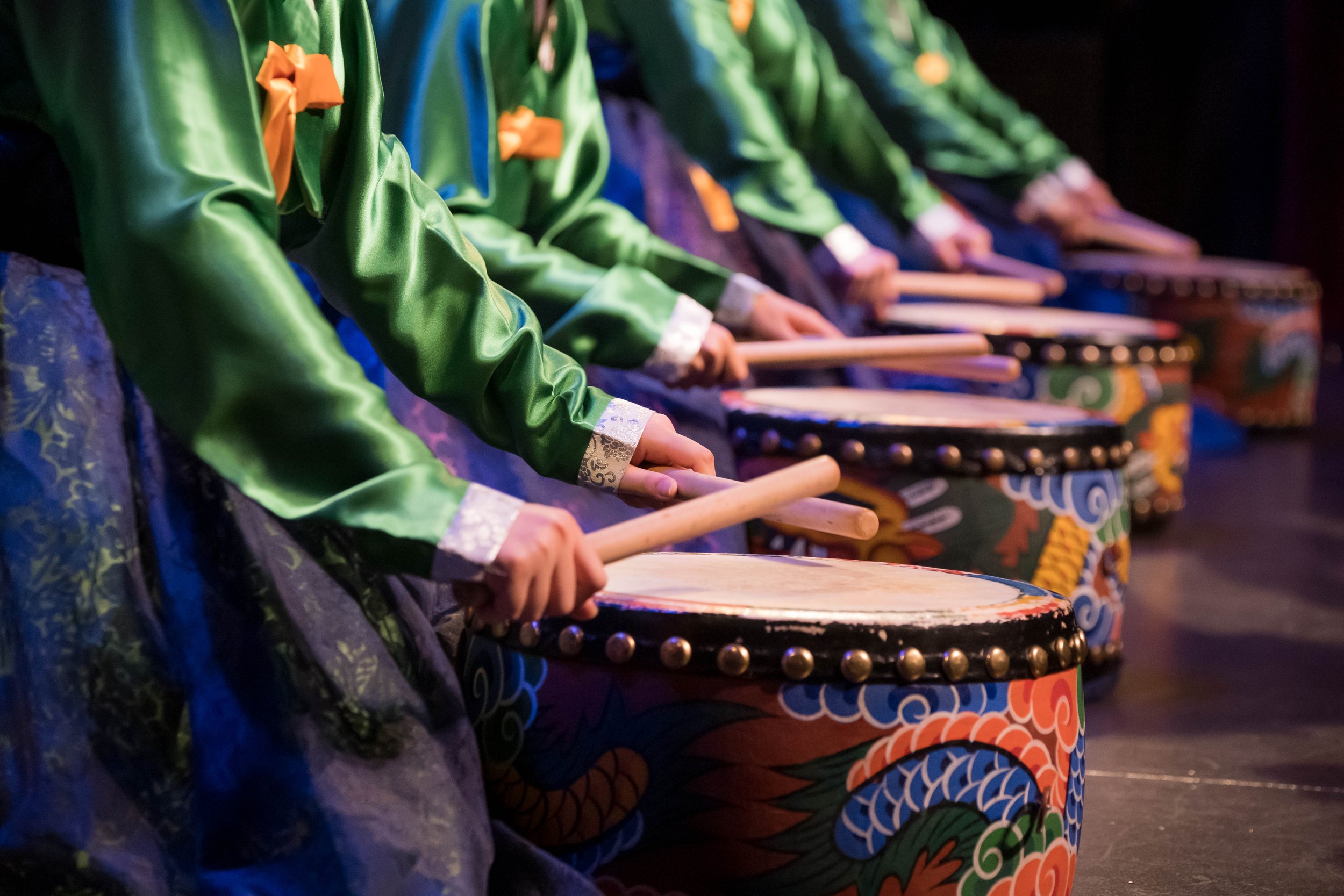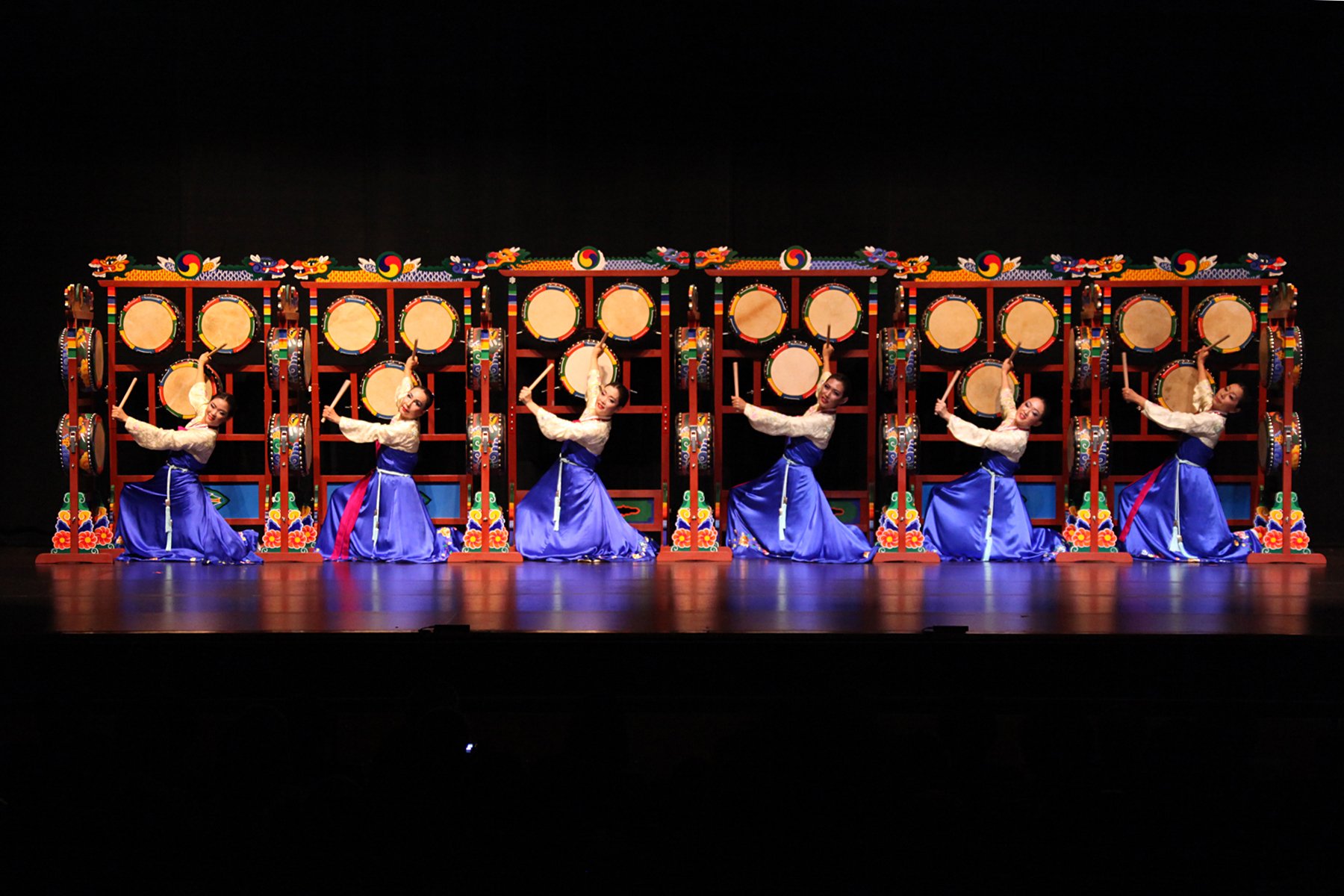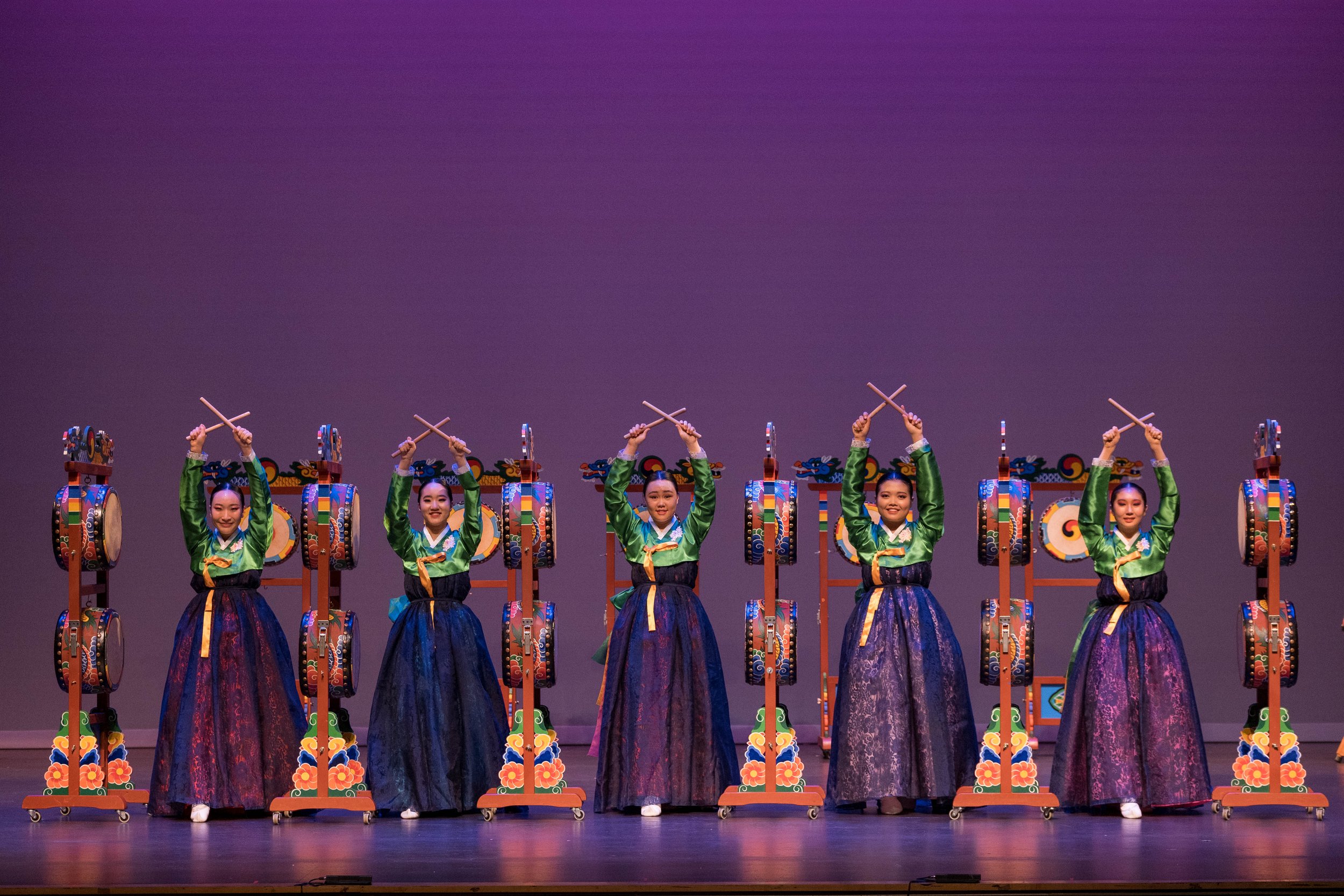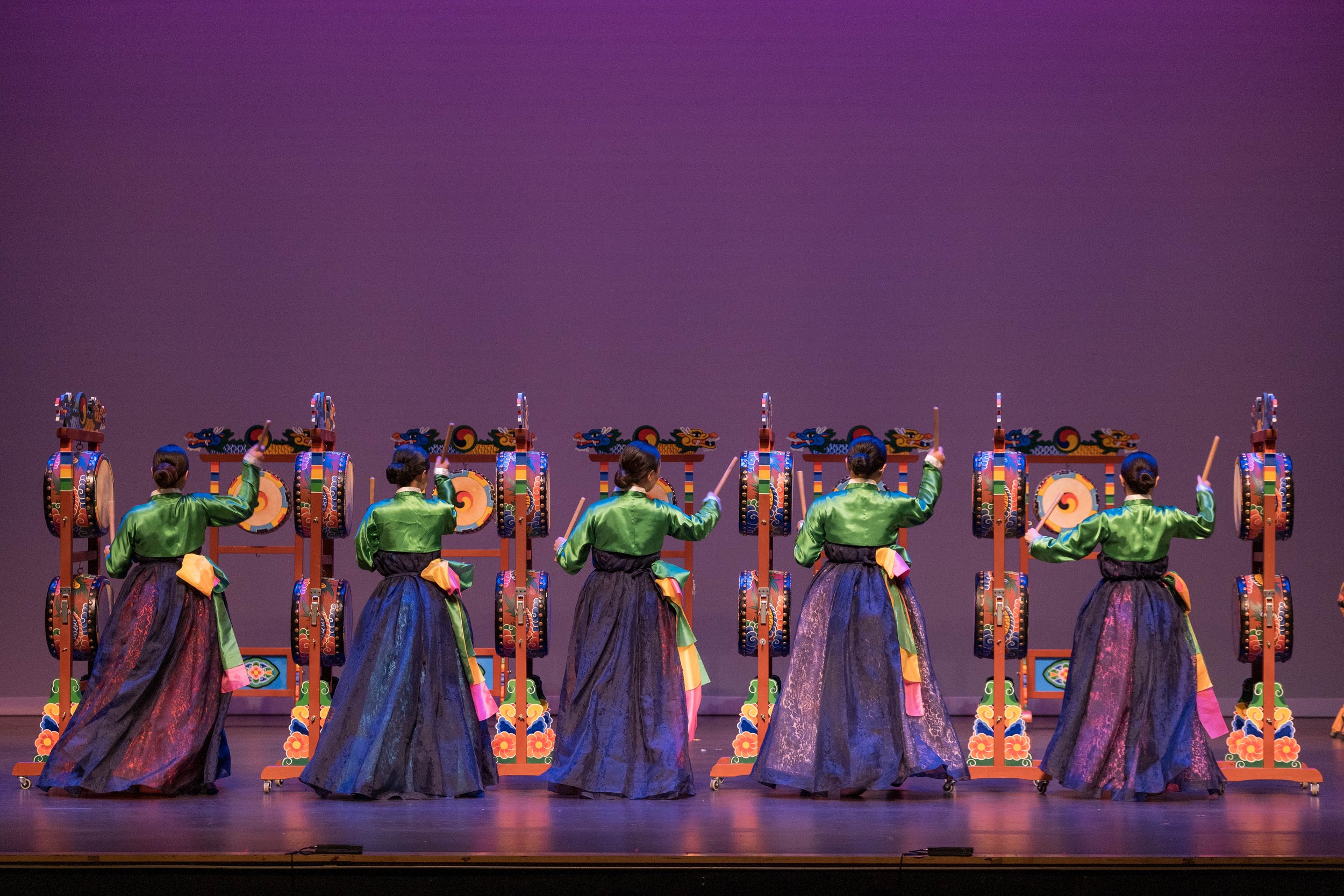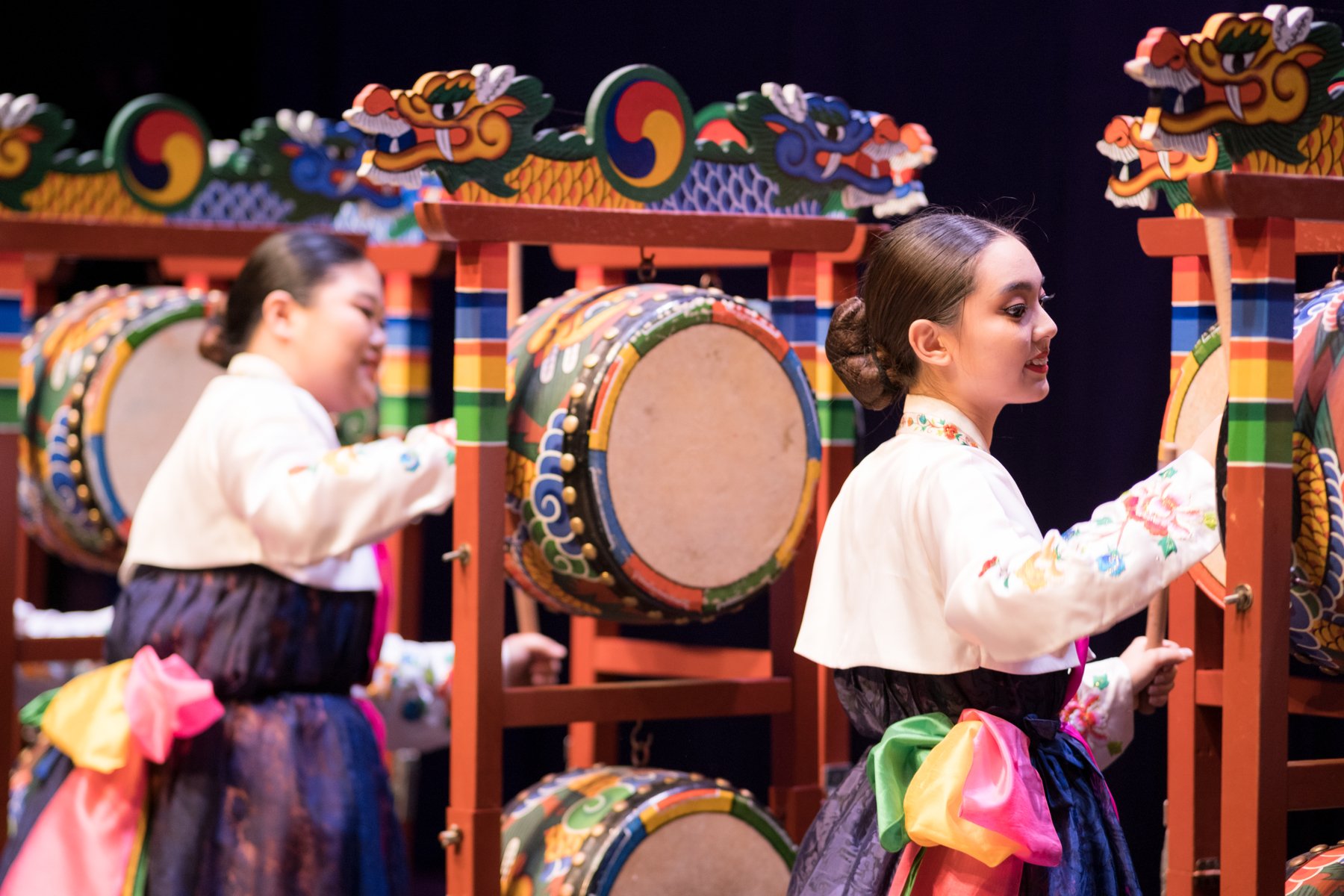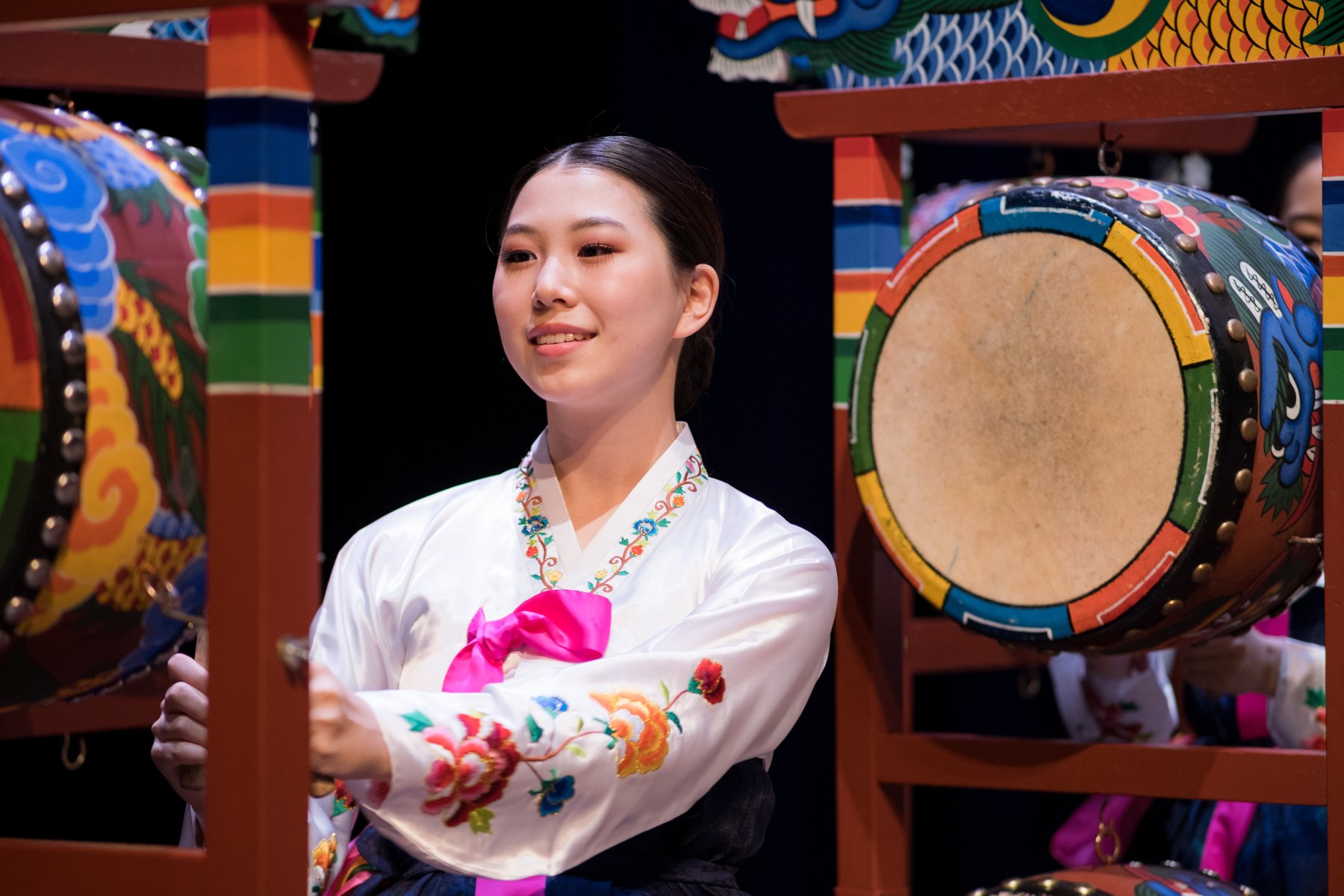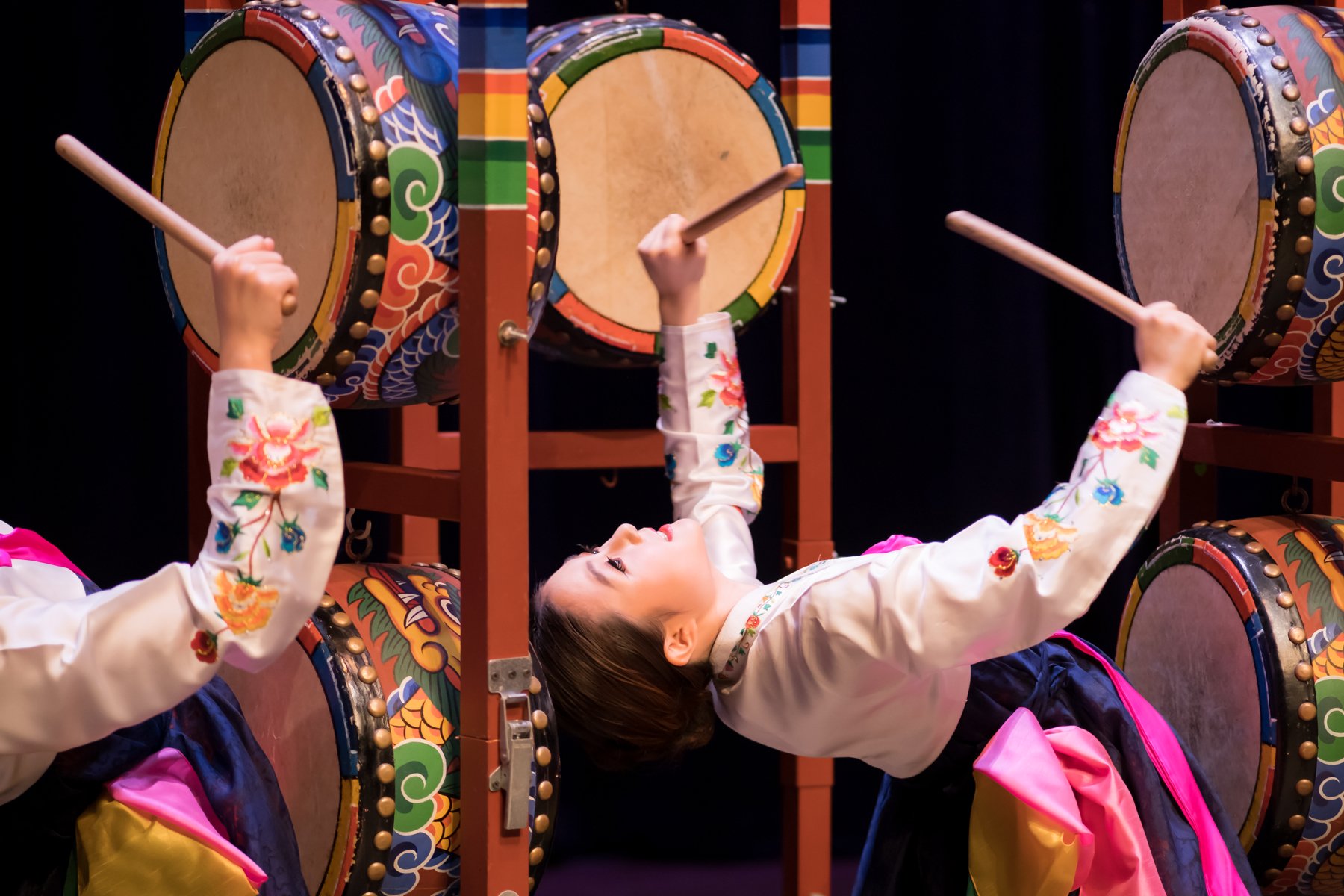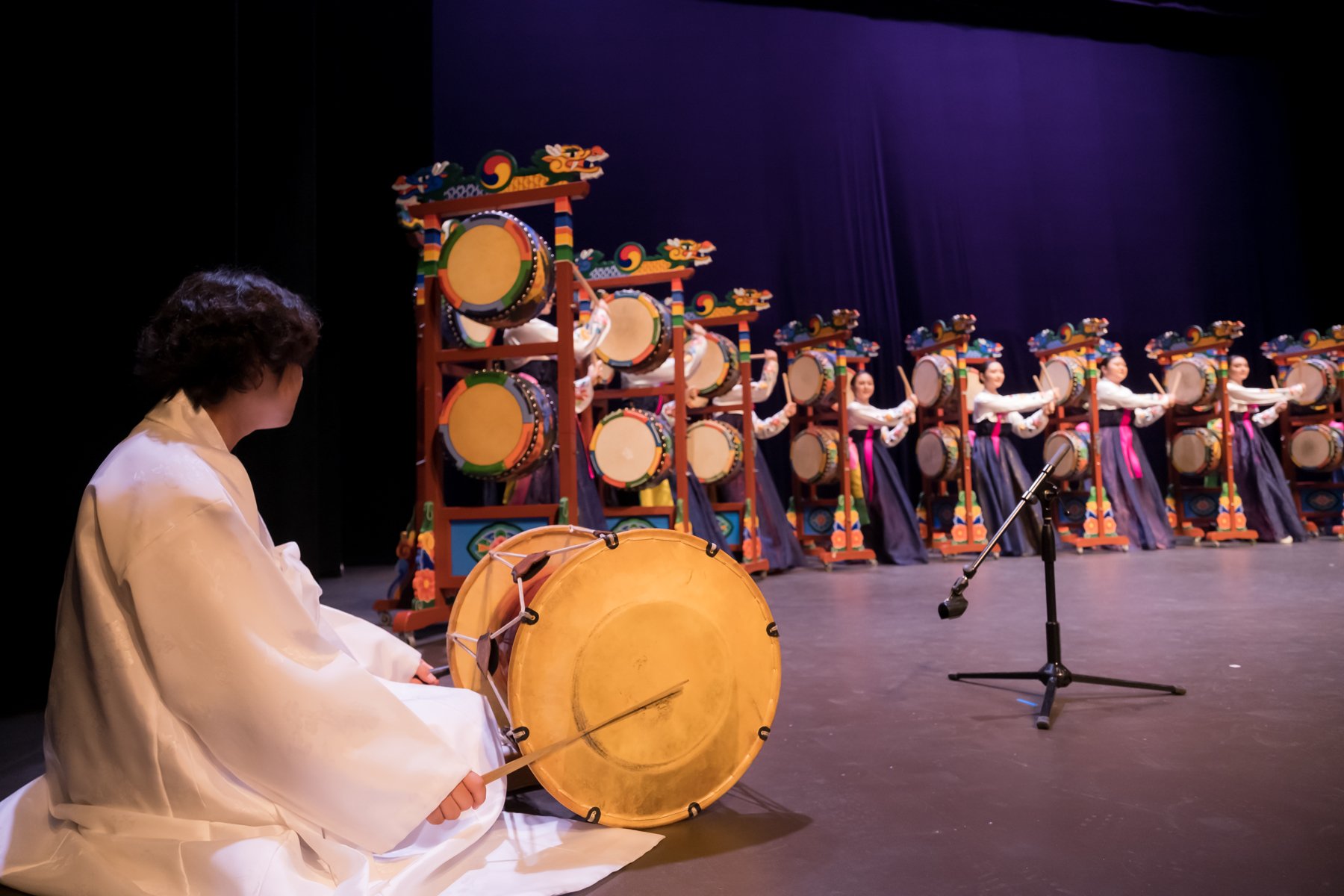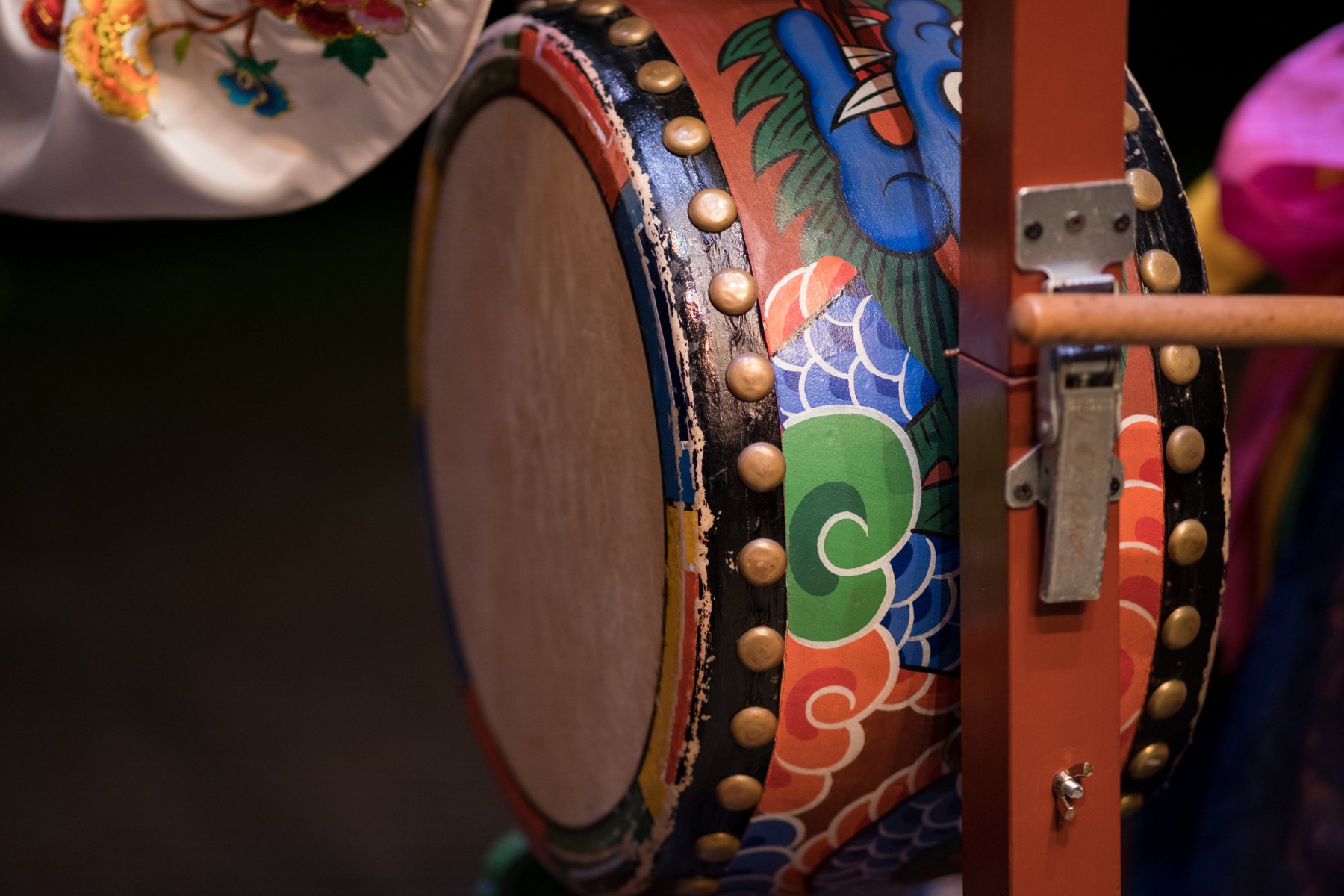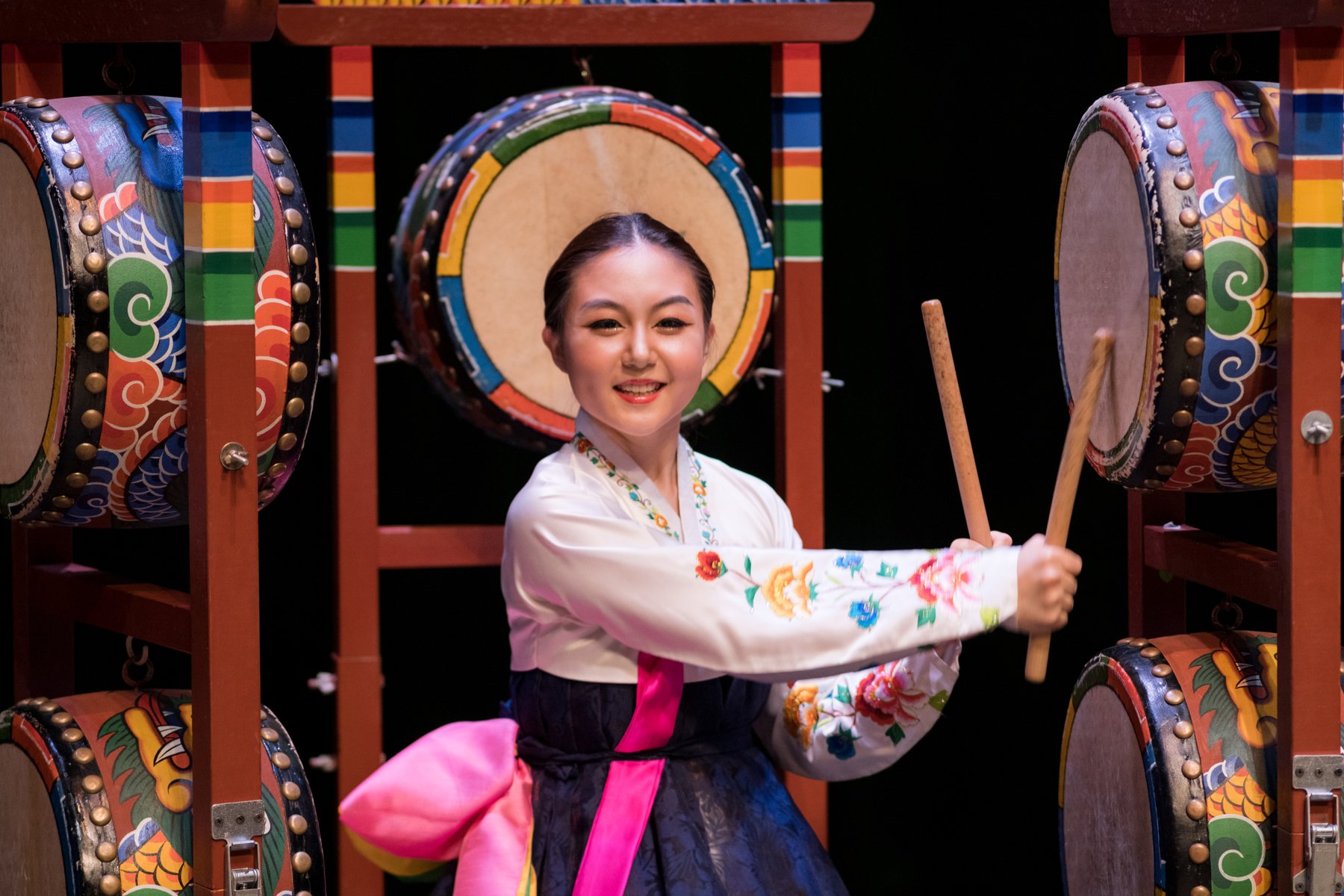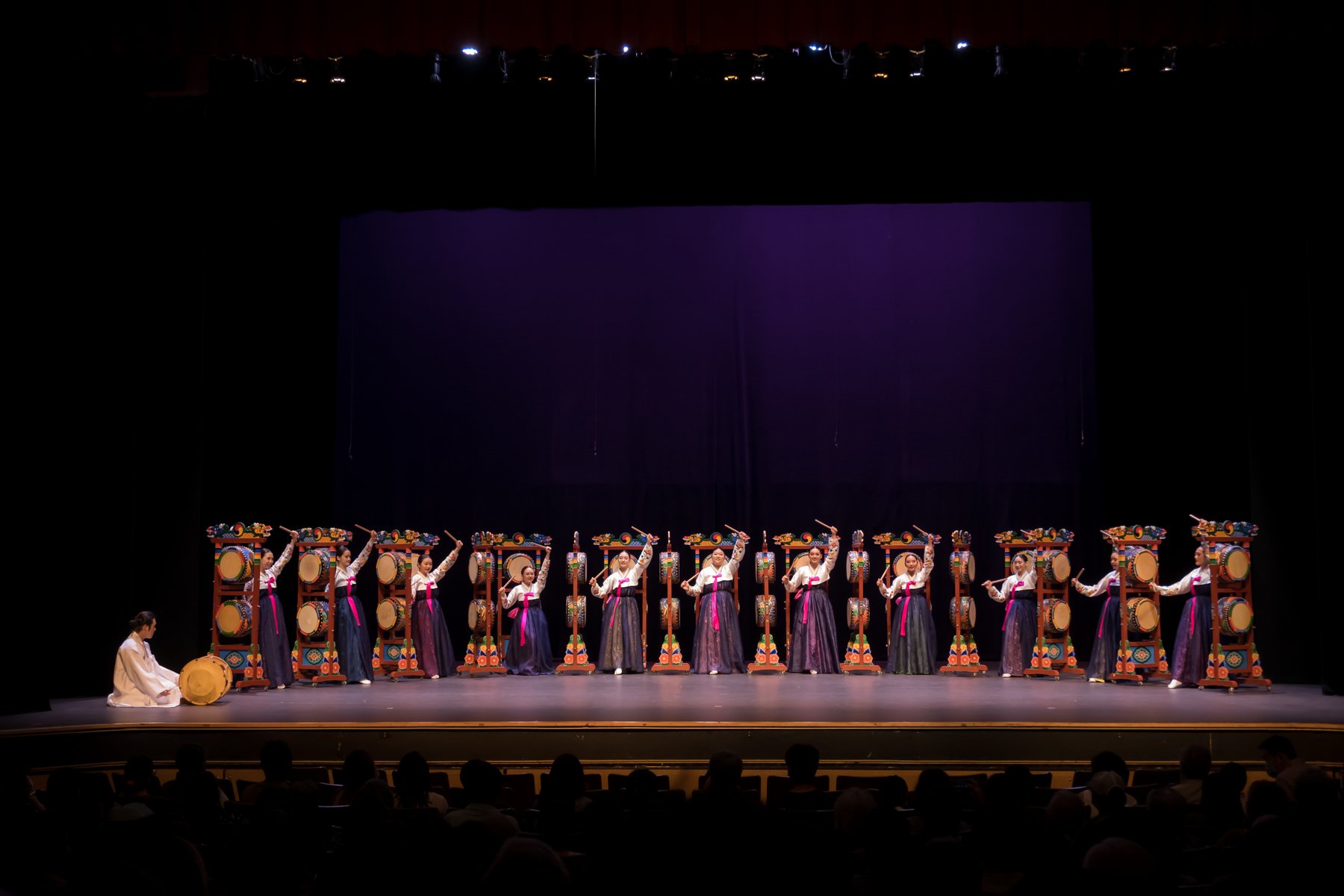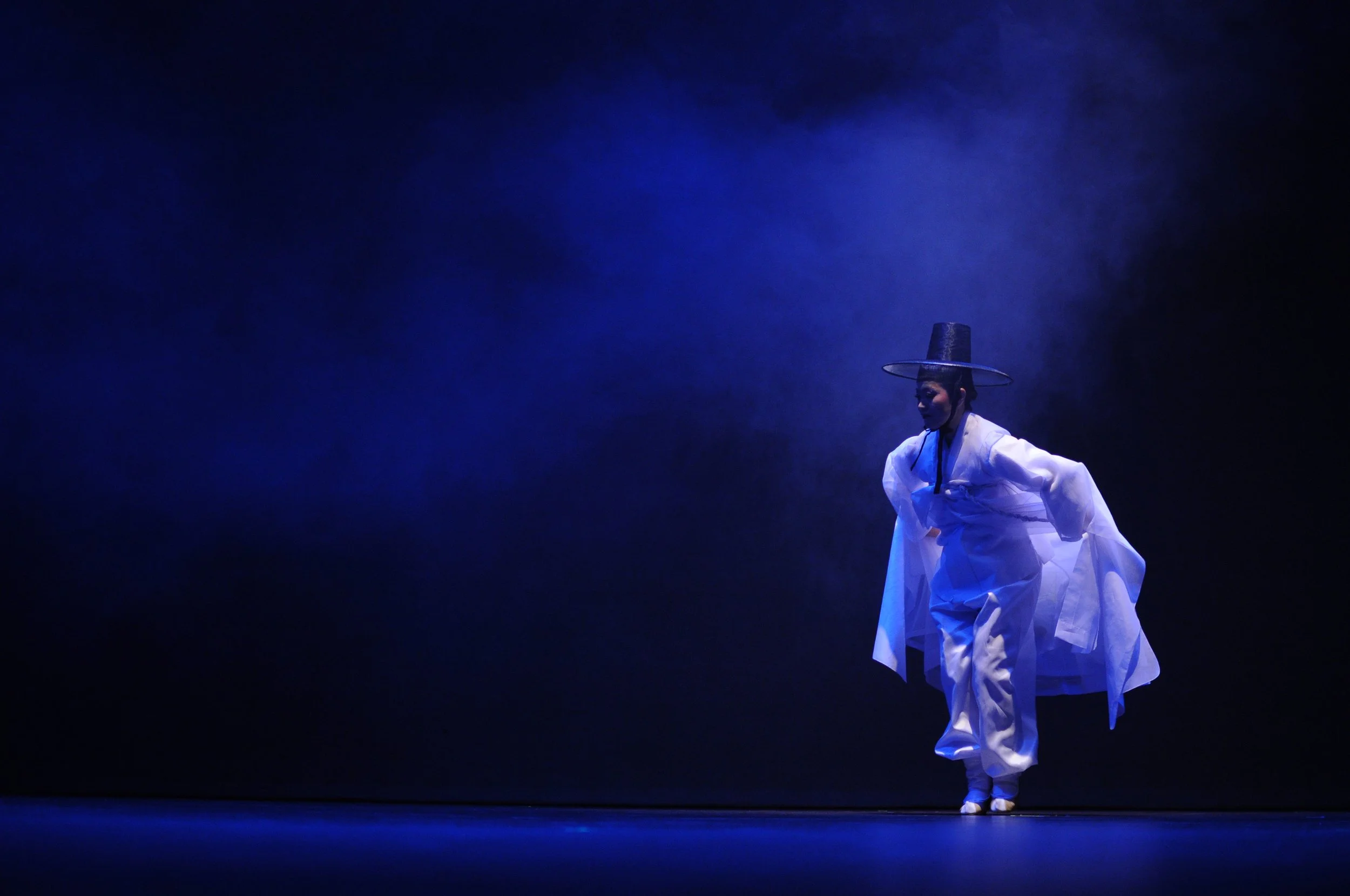Our History
The Chicago Korean Dance Company (CKDC) is a non-profit organization whose mission is to introduce Korean performing arts to the Korean-American community and to mainstream America. It was established April 1, 2009 by Dr. Aedeok Lee, the Director of CKDC, together with numbers of other professionally-trained dance teachers from Korea.
In October of 2009, the Chicago Korean Dance Company gave its first grand performance, entitled “Exploring the Pulse of Korean Dance.” Since this inaugural presentation of traditional Korean Cultural Heritage dances, five additional grand performances of both traditional and modern interpretations of Korean dance have been presented every two years. They include “Breath of Korean Dance” in 2011, “Storytelling through the Beauty of Korean Dance” in 2013, and a series of “Collage of Korean Dance” performances in 2015, 2017, and 2019. All performances received many accolades for presenting the authentic art of Korean dance, not only through traditional forms but also original modern choreography.
The CKDC Youth Group was established in 2010 to provide high quality Korean cultural education to second-generation Korean-American children. Its work includes special performances at public schools, libraries, and museums in the greater Chicago area and the Midwestern region. In addition, the Korean Dance Institute was established to offer classes to the general public and to welcome anyone who may be interested in learning Korean dance. In 2014, CKDC launched the “International Korean Traditional Performing Arts Competition,” as another means to promote awareness of Korean culture.
CKDC serves as an ambassador of Korean culture through traditional Korean dance. Its reputation has grown beyond the Midwest. The group has performed by invitation in New York and Italy, and at the request of the Embassy of the Republic of Korea in Chicago, Nicaragua, Brazil, and Norway.
시카고 한국무용단은 한국문화의 전문성과 전통을 살리기위해 미국 시카고 교민들중 무용을 전공한 사람들로 구성하여 전통무용가인 이애덕씨에 의해 창단 되었다.
무용단은 2009년 4월 1일 기자 회견을 통하여 첫 창단식을 가졌고 2010년, 한국문화 계승의 중요성을 알리기위해 2세 청소년(3학년~12)들로 구성된 어린이 무용단을 창단하였으며, 우리춤을 배울 수 있는 부설기관인 '한국무용원'을 창설하여 교민들의 정서생활과 공연활동을 위한 기관도 창립하였다.
2009년 10월 창단공연을 시작으로 2년마다 대 공연을 올렸는데 2009년은 한국무형문화재 종목 춤으로 ‘우리춤의 뿌리찾기’, 2011년 ‘전통과 창작의 만남’, 2013년 ‘이야기가 있는 우리춤’, 2015~2019 ’우리춤 아우르다’로 주류사회 공연을 통하여 전문적이고 보다 수준있는 한국무용을 선보였다는 호평을 받았다. 한국의 전통무용을 선보인것은 물론 교민사회에서 볼 수 없던 전통을 기반으로하는 창작무용과 다양한 북을 모아 다채롭게 구성하는 북의 향연을 선보였으며 어린 아이들을 위한 한국의 설화나 소설, 동화 등을 무용극으로 새롭게 안무하여 선보였다.
2014년 무용단 전공인을 중심으로 한국전통예술경연대회(International Korean Arts Competition)를 개최하여 한국의 무용과 음악을 경연할 기회를 마련하였다. 경연대회는 한국 문화를 사랑하고 아끼는 비전공인들이 참가하는 무대로 자신의 실력을 가늠하는 기회를 제공함과 동시에 재능인들을 발굴해 한국 전통문화를 보존하고 전승하는 역할을 하고 있다.
무용단은 일리노이 비영리 문화단체로 등록하여 시카고의 문화를 바꿔놓는 전문적인 한국문화 단체로 우뚝 올랐다. 주류사회 기업, 기관, 학교 등 다양한 초청공연이 이루어지고 있으며 특히, Kimberly, KOTRA 기업공연과 뉴욕, 이태리 현지 공연을 하였으며 박물관, 학교 등 다양한 문화행사에 초청받고 있다, 무용단은 시카고 총 영사관은 물론 니카라과, 브라질, 노르웨이 대사관의 해외 초청공연으로 한국문화를 알리는 데 기여하였다.
About Korean Dance
Korean dance has a long history and is mainly divided into court dance, folk dance, and original choreography.
Court dance was performed at the palace for the royal family or for ambassadors. Court dance was performed on a large scale, with magnificent costumes. However, the movements themselves were extremely moderate and restricted and the purpose of the dance was to pray for the longevity of the King or for a peaceful country.
In contrast, folk dance was for peasants. They did not have any restrictions on movement, so folk dances are unique to each province and free in terms of movements. Due to this freedom, peasants were able to express their artistic ability as they pleased. They could even create satires of the nobility or social critique like the mask dance.
In the modern day, Korean contemporary dance creates new messages for today’s world out of the elemental movements of traditional Korean dance.
The drum dance is used to excite workers in the agricultural community. In Korea, it has been performed not only in farming society, but also at village festivals, religious ceremonies, and villagers’ celebrations. There are many types of drums in Korea, so there are many diverse drum dances.
The Chicago Korean Dance Company (CKDC) is a nonprofit organization whose mission is to introduce Korean performing arts to the Korean-American community and to mainstream America. It was established April 1, 2009, by Dr. Aedeok Lee, the director of CKDC, together with four other professionally trained dance teachers from Korea.
뿌리깊은 역사를 지닌 한국무용은 크게 궁중무용과 민속무용, 창작 한국무용으로 나뉜다. 궁중무용은 궁궐에서 추는 춤으로 궁궐행사나 외국 사신들에게 보이기 위해 추어졌다. 궁중무용은 의상이나 규모는 굉장이 크고 화려하였지만 춤의 동작은 극도로 절제되었고 자유롭지 못했다. 반면에 민속무용은 서민들이 추는 춤으로 각 지방마다의 특색을 지니며 제약을 받지 않으므로 춤 동작도 자유롭고 춤의 종류도 다채롭게 발전되었다. 서민들은 개인의 예술적인 감각을 맘껏 나타낼 수도 있었고 탈춤같이 양반을 풍자하거나 사회를 고발하는 춤도 있었다. 일제시대(1910년 8월 29일 ~ 1945년 8월 15일)를 겪으면서 한국문화는 존폐 위기에 있었으나 예인들에 의해 이어졌고 광복 후 새로운 분위기의 신무용기를 맞이하면서 춤의 형태도 변화하여 오늘날의 한국민속춤의 틀이 마련되었다. 현대에 들어 창작 한국무용은 한국춤의 기본 춤사위를 가지고 오늘날의 새로운 감각과 새로운 메세지를 전하는 춤을 만들어내고 있다.
시카고 한국무용단은 전통적으로 내려오는 궁중무용과 무형문화재로 지정되어있는 민속무용을 공연하며 또한 한국춤의 기반으로 새롭게 무용단이 안무한 창작 민속무용과 현대적 시각의 한국 창작무용을 선보이고 있다.
International Performances
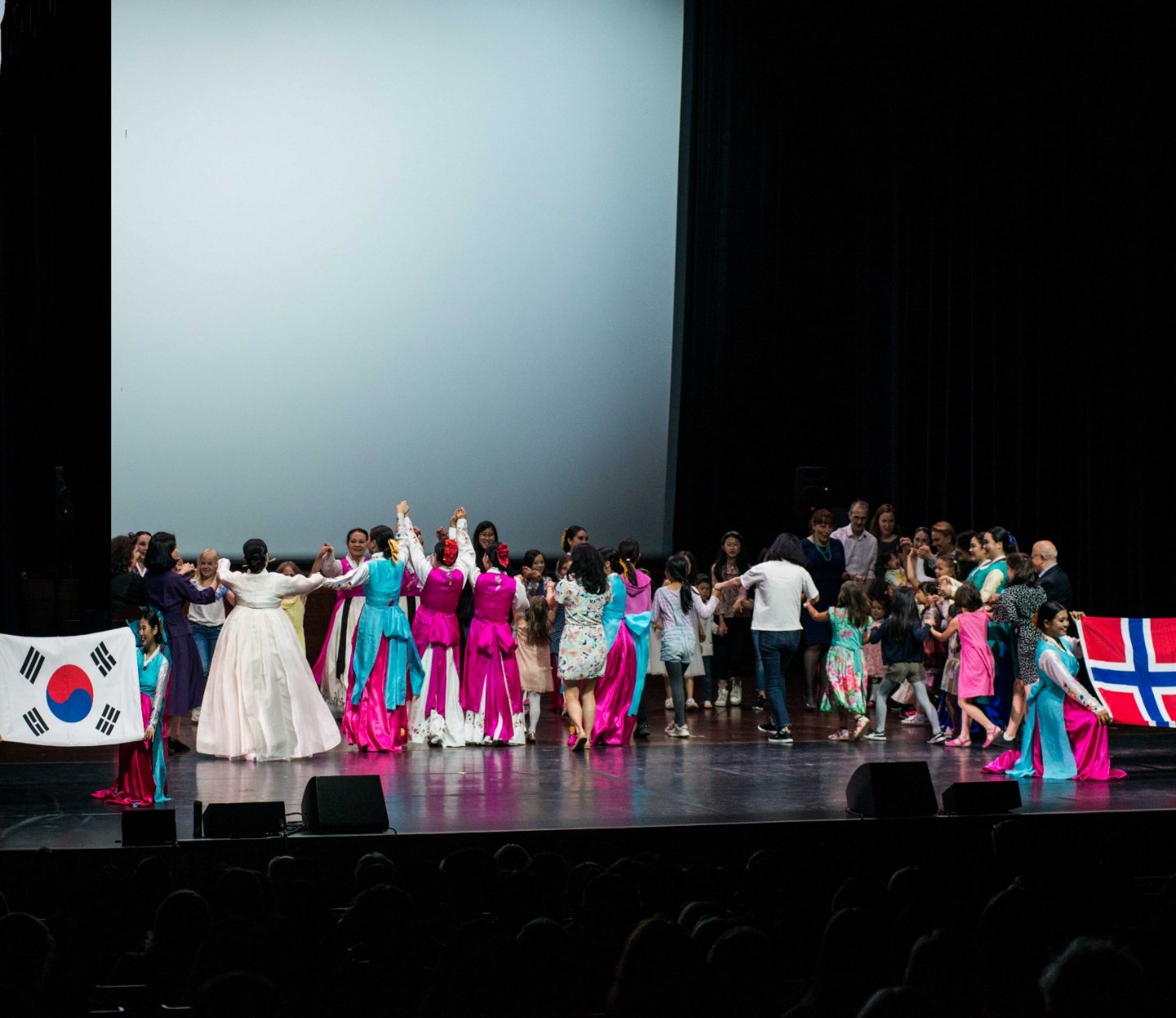

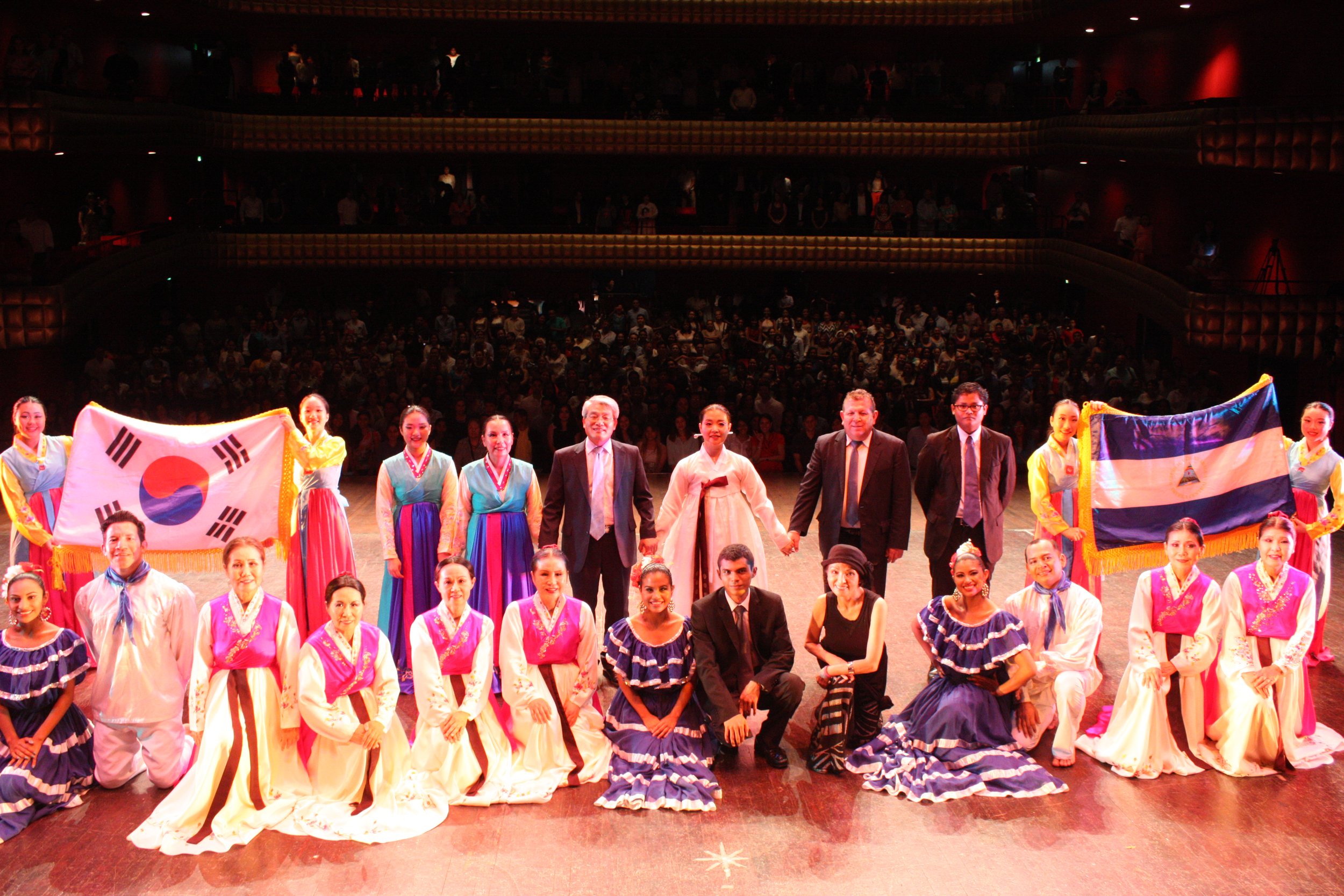
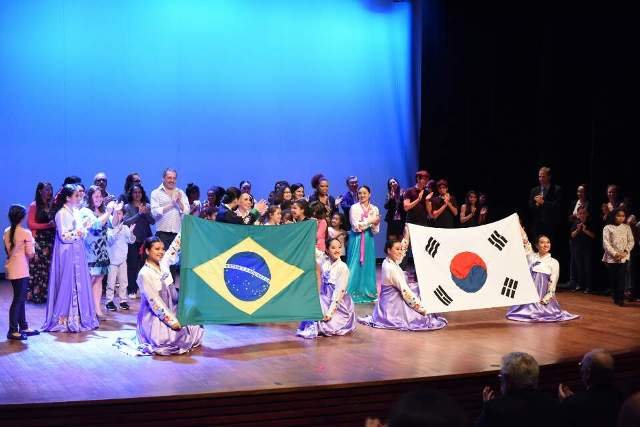
Selected Dances
Taepyungsungdae (Reign of Peace)
태평성대
“Taepyungsungdae” refers to a reign of peace, created when a king rules the country well. This dance includes the “uimul,” rich ceremonial banners used when the king made an official appearance. Of special note is that the king and queen danced together for the prosperity of the palace. In this dance, you will be able to see the unique costumes of the Korean palace and feel the magnificent and splendid rhythms of Korean traditional music, which slowly accelerates the excitement within you.
임금이 나라를 잘 다스려서 평화로운 상태를 창작화한 춤이다. 이 춤은 궁중의 의복과 임금이 등장할때 사용했던 궁중의 의물을 제작하여 궁중무용의 현장감을 더하였다. 특히 왕과 왕비가 함께 춤을 추어 풍성한 궁중의 모습을 볼 수 있게 하였다 한국전통음악의 느린 장단에서 빠른 장단으로 이어지는 웅장함과 화려함을 느낄 수가 있을 것이다.
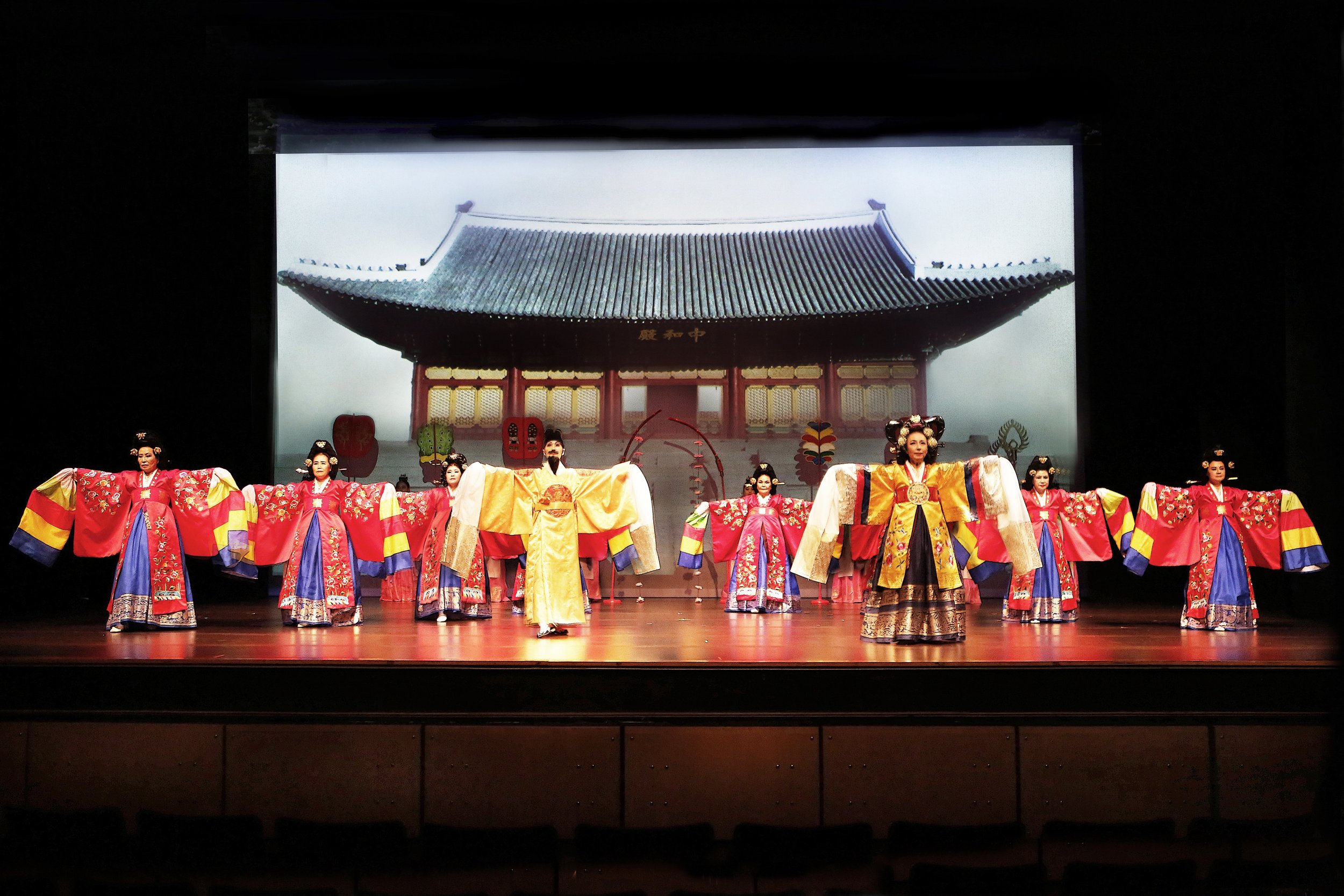
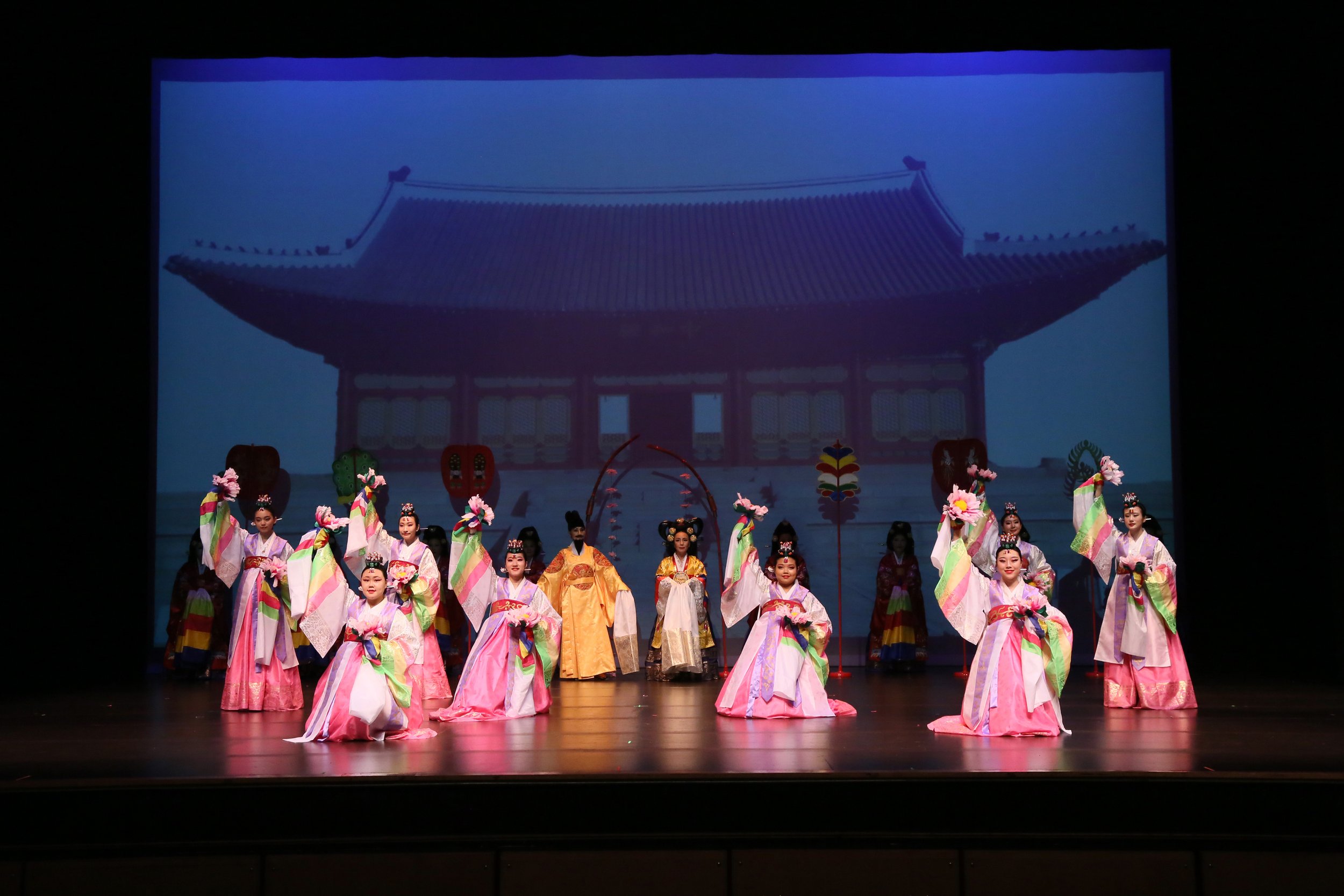
Salpuri Choom (Freedom from Sorrow)
살풀이 춤
“Salpuri dance” is the 97th of Korea’s Principal Intangible Cultural Properties. It is danced to a Salpuri beat with a long piece of cloth. “Salpuri” means to “relieve the grudge away.” It originated in the shaman’s dance to get rid of bad energies. However, it has since developed into a dance to represent the Korean emotion of sadness, “Han.” Although Salpuri dance begins in the heavy emotions of sorrow and regret called “Han,” the dance does not end with the sadness but expresses the human nature to overcome grief and hardship.
무형문화재 제 97호로 지정된 살풀이 춤은 긴 수건을 가지고 살풀이 장단이라는 국악 음악에 맞추어 추는 춤이다. 살을 푼다, 즉 나쁜 기운을 없애준다는 무속에서 유래되었으나 현재는 무속의 형식이나 동작은 보이지 않는다. 살풀이는 우리 민족의 정서와 한을 대변하는 예술적 형태의 춤으로 발전되었다. 살풀이 춤에 내재된 심성은 깊은 한이지만, 단순히 슬픔에 머무는 것이 아니라 환희와 신명의 세계로 승화시키는 이중 구조의 인간적 감정을 표현한다.

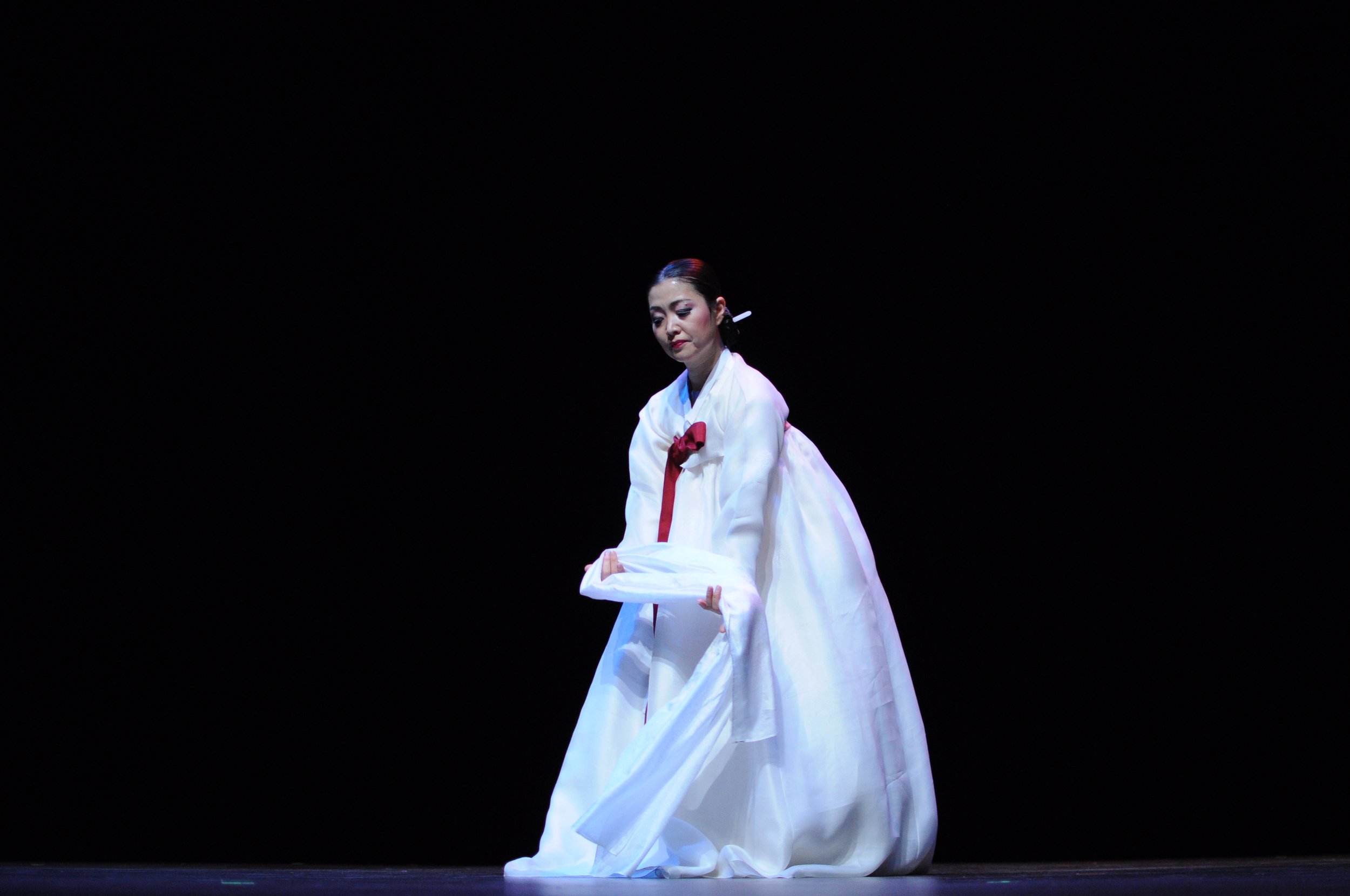
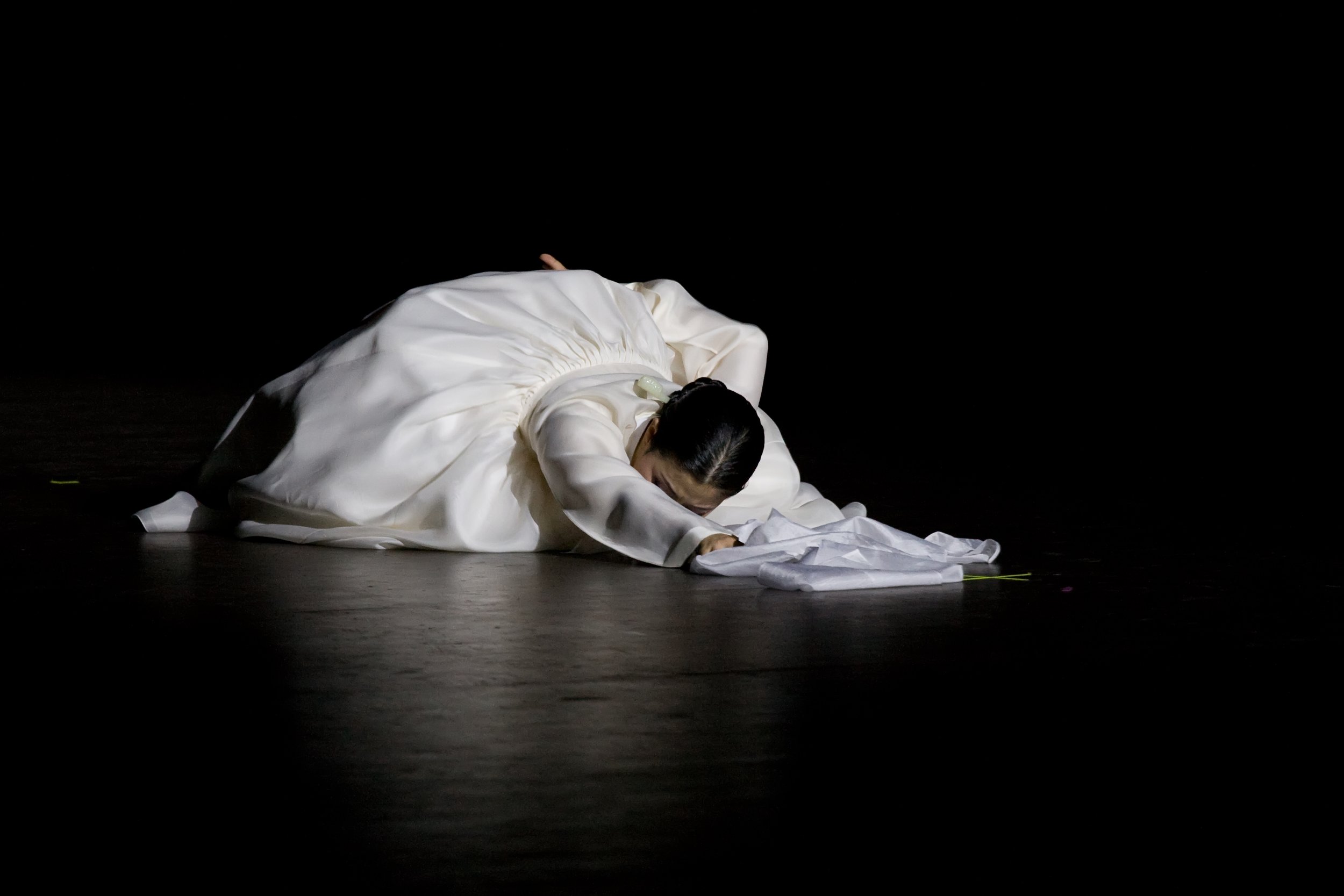
Buchae Choom (Fan Dance)
부채춤
The fan dance is regarded as the most distinctive Korean traditional dance, one that symbolizes flowers and butterflies. It was originally performed by a single dancer but since 1990 became known as a collective dance representation. The basic idea of the movement is how to harmonize the dancers' bodies with the fans to make beautiful figures in space. One can imagine a large, beautiful flower in full bloom in the choral dance, while others make waves like water.
부채춤은 한국의 대표적인 민속무용으로 원래는 독무로 추어졌고 1900년대 신무용기에 군무 형태로 소개되었다. 각 나라별로 부채를 지닌 춤이 많으나 연출방법이 소도구나 장식품으로 취급하는 등 형식적일 뿐이다. 한국의 부채춤은 두손으로 부채를 펴고 접고 돌리고 뿌리면서 아름다운 꽃과 나비를 상징하거나 파도 모양을 표현하는 등 부채의 우아한 선을 잘 살려내었다.

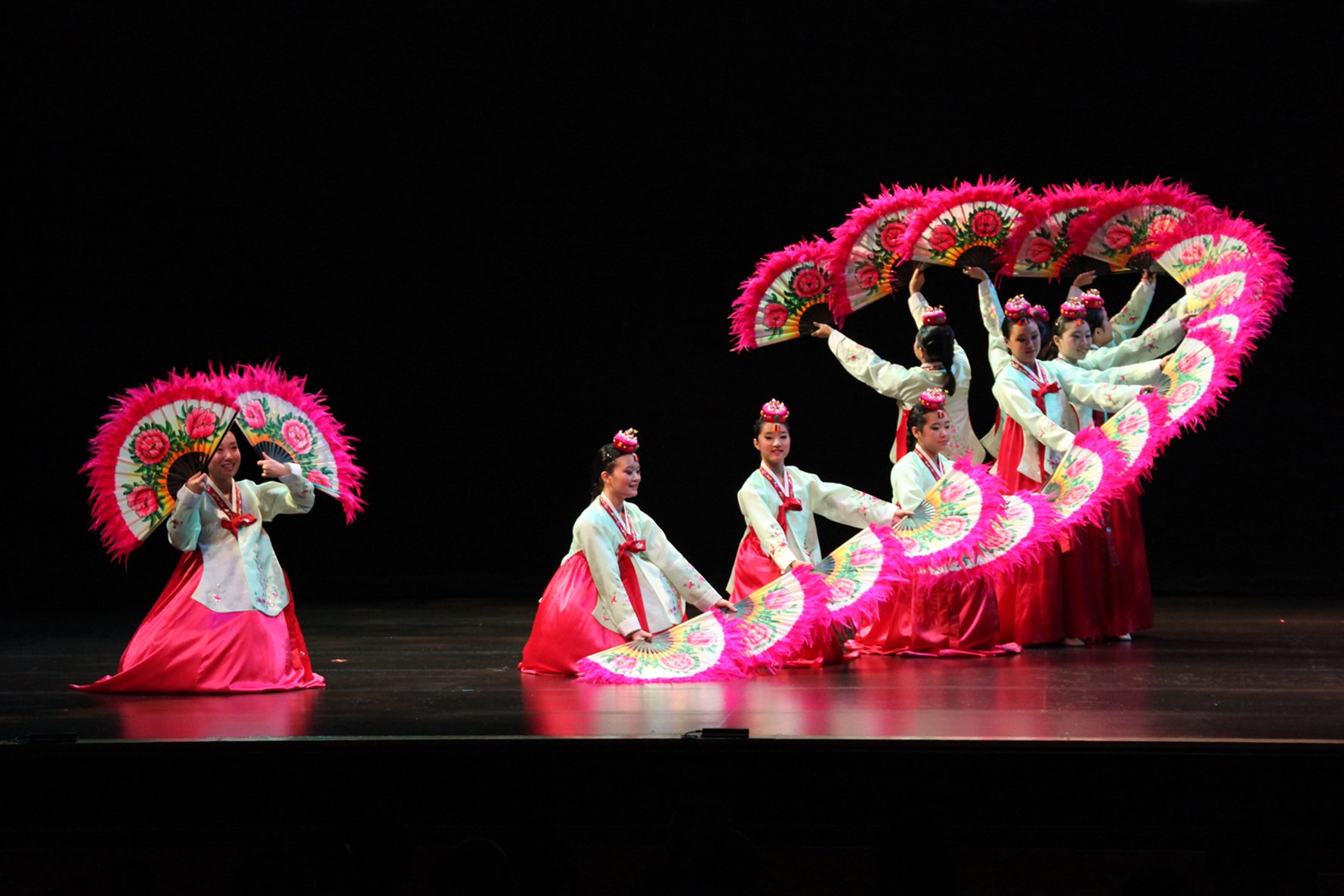
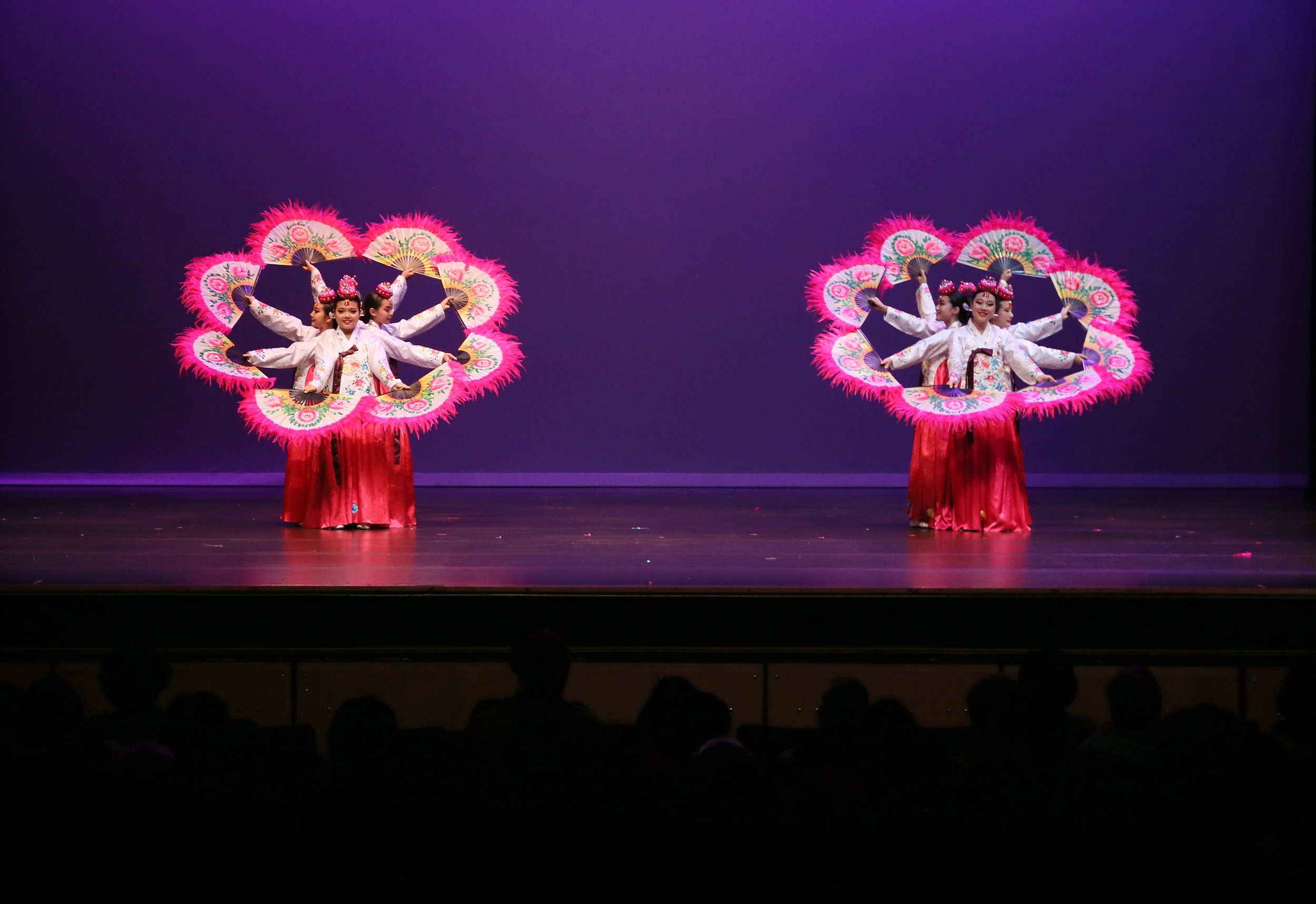
Seungmu (Dance of Serenity)
승무
“Seungmu,” a folk dance that may have originated in Buddhist tradition, shows an elegant charm unique to Korean dancing in the curve of the body’s movements and the shape of the dancer's feet in “beoson,” a soft, curved silk boot. The beauty of spatial composition in this dance sublimates the human to the state of inner philosophy. The grand ensemble of drums heralds deliverance from anxiety and reveals how ecstasy and dance are blended. This dance is designated as the 27th item on the list of Korean Principal Intangible Cultural Properties.
중요무형문화재 27호인 승무는 한국민속춤의 정수라 할 만큼 격조 있는 춤이다. 승무의 유래는 여러 설이 있으나 불교의 영향을 받은 듯하며 지금은 종교적인 성격보다 민속춤으로 맥을 잇고 있다. 승무는 최고의 춤사위와 긴 소매를 지닌 장삼 속에 보여지는 몸의 곡선, 버선 발의 모양 등 한국 춤 만이 간직한 단아한 매력을 보여준다. 이 춤은 인간내면이 철학의 경지로 승화된 춤으로 고뇌에서 해탈 그리고 환희를 맞는 북소리가 함께 어우러진다.
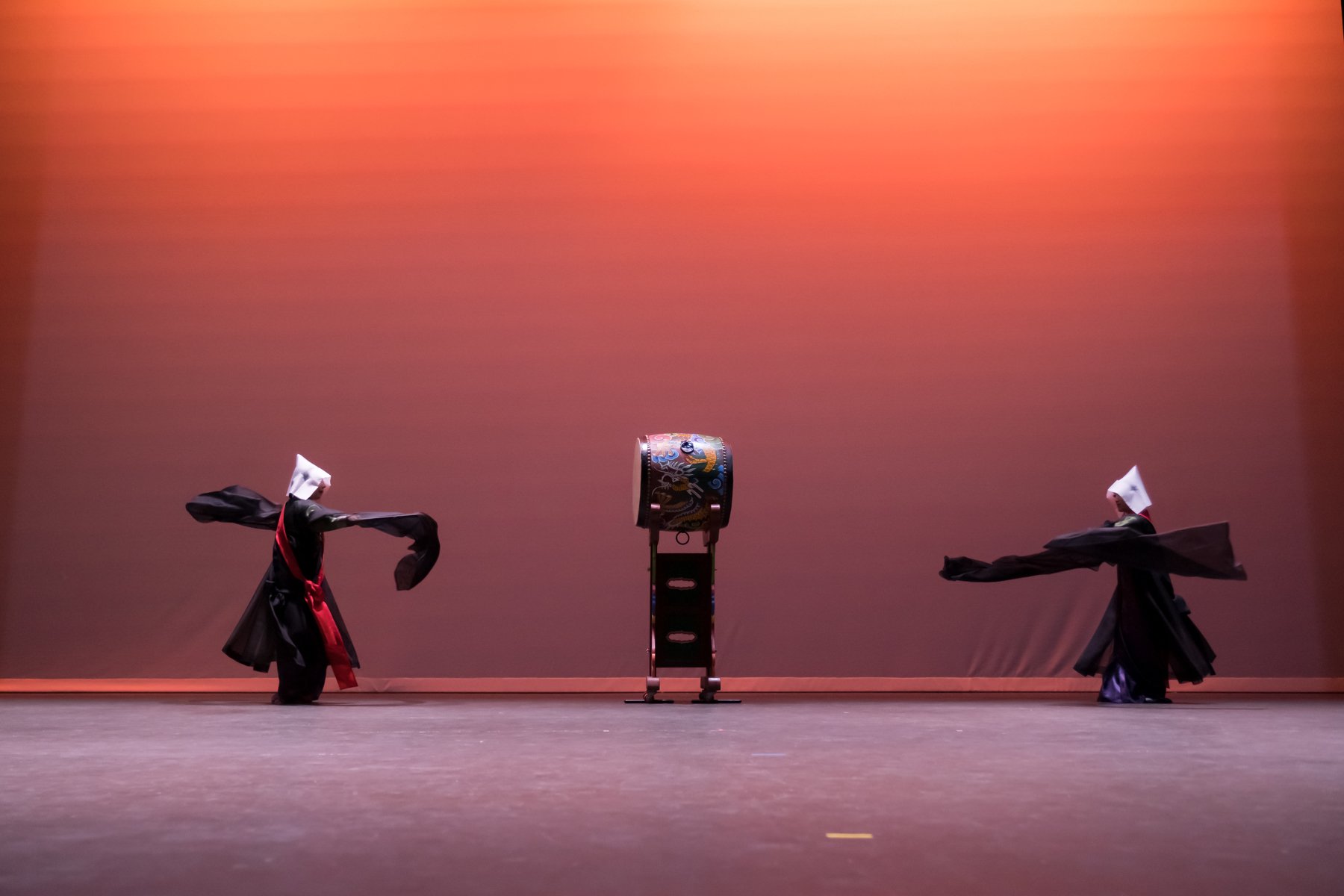

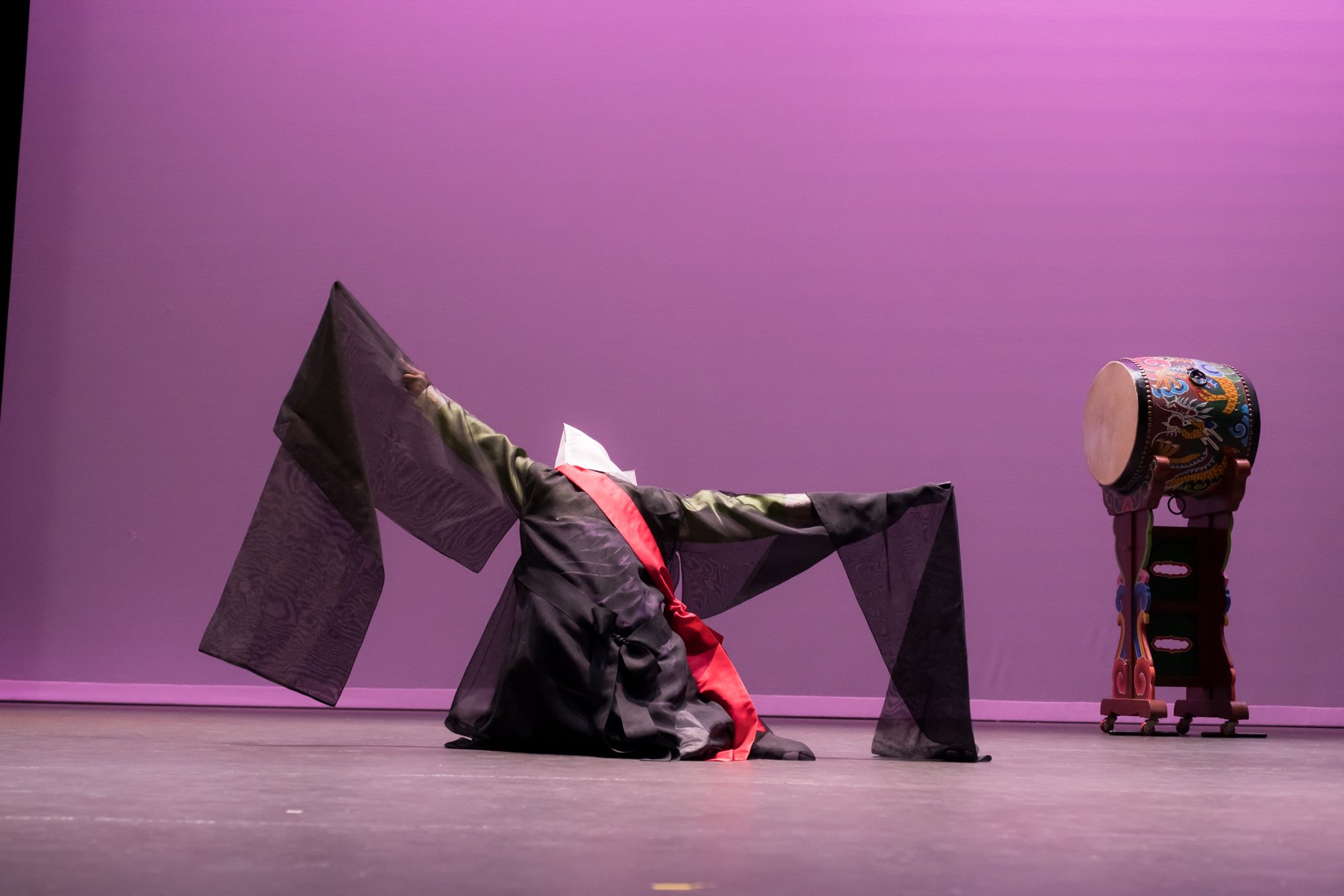
Taepyungmu (Dance of Prosperity)
태평무
“Taepyeongmu” is the 92nd item of the Korean Principal Intangible Cultural Properties. It originated during the Joseon dynasty about 100 years ago. It was danced by the king and the queen to pray for the peaceful prosperity of the kingdom. Royal costumes are worn during the dance, but the music of the dance and the dancers’ dynamic yet light footsteps show the characteristics of folk dance rather than court dance.
민속무용으로 중요 무형 문화재 제92호로 지정 된 태평무는 약 백년 전 부터 추어 온 것으로 나라의 태평을 기원하는 춤이다. 경쾌하고, 가볍고 절도있게 몰아치는 장단에 빠르게 딛는 발 디딤새가 특징이며 의상은 왕비의 복식으로 궁중의상과 비슷하나 춤사위는 궁중무에서 벗어나 활달하고 민속춤에서 볼 수 있는 흥과 멋을 보여준다.
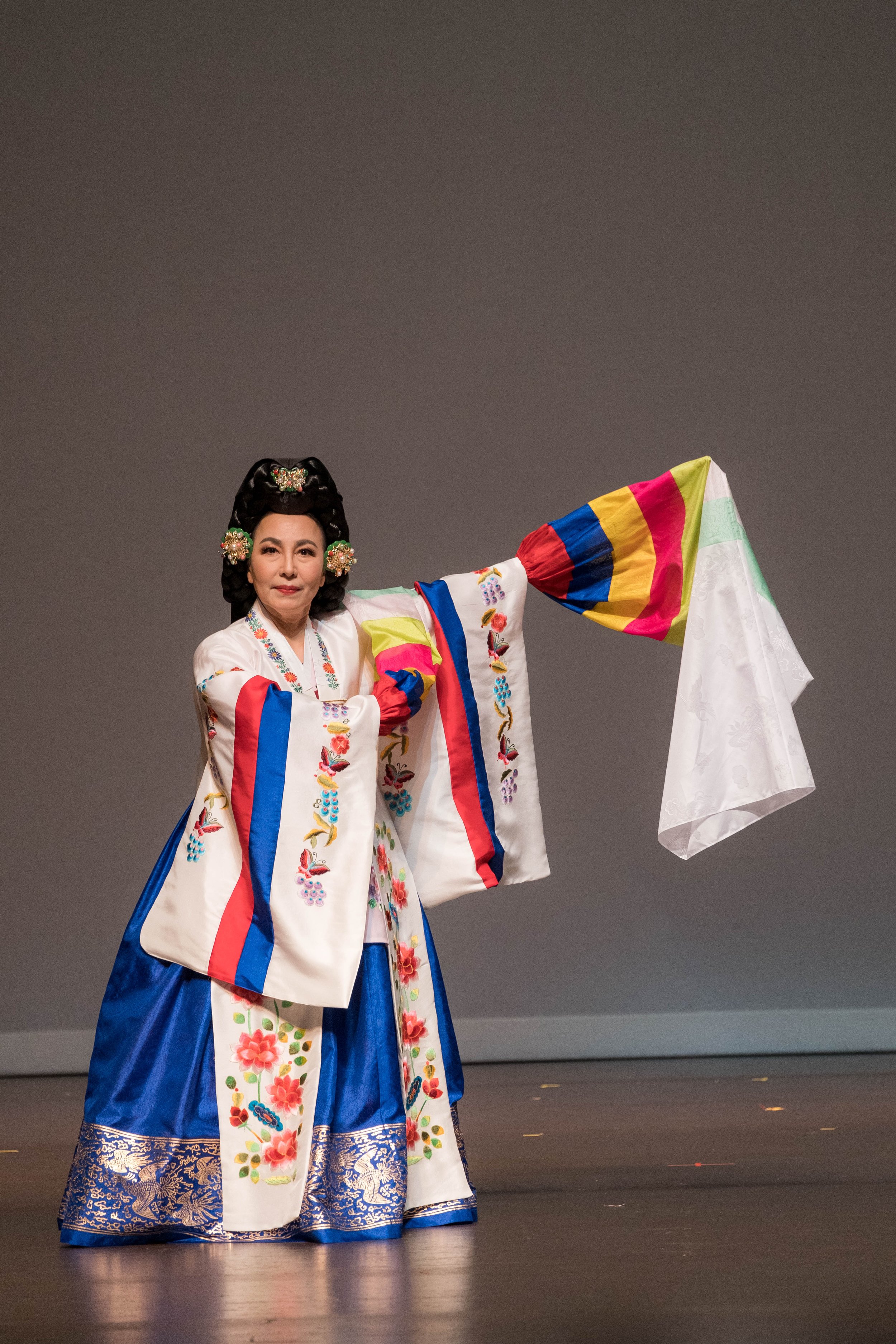
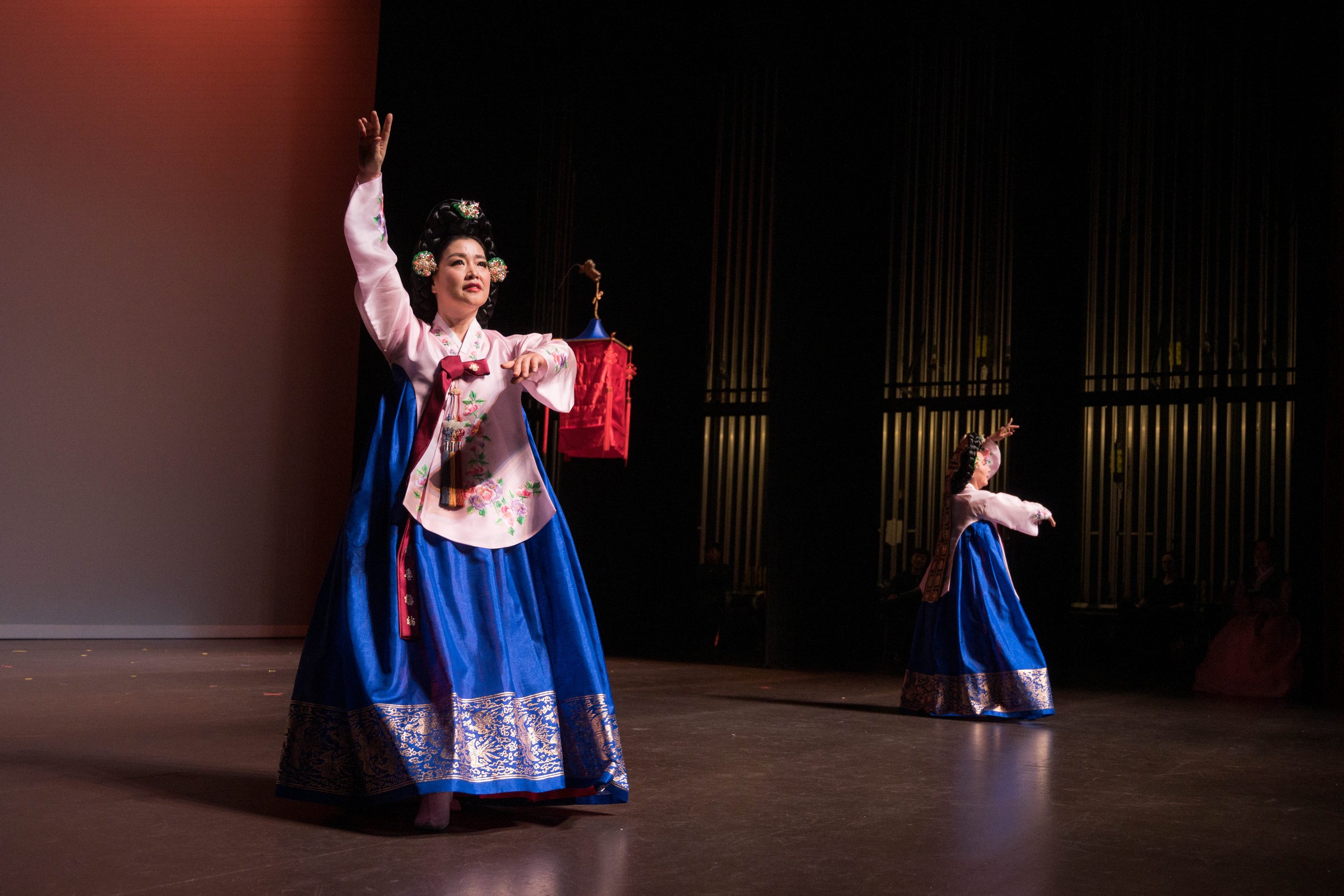
Ganggangsullae
강강술래
“Ganggangsullae” is a Korean folk dance, which is the 8th of Korea’s Principal Intangible Cultural Property and was designated as an Intangible cultural heritage by UNESCO in 2009. The dance portrays the different lifestyles of mainly farmers and fishers. Dancers hold hands together and form a circle in celebration of the harvest during the Korean Thanksgiving, also known as “Chuseok.”
강강술래는 국가무형문화재 제 8호이며, 유네스코 인류구전 및 무형유산 걸작으로 선정된 한국의 민속놀이이다. 강강술래는 다같이 손을 잡고 도는 원형무의 형태를 가지고 있으며 노래에 맞춰 덕석몰이, 고사리 꺾기, 청어 엮기 등, 한국의 농촌이나 어촌 생활을 표현하여 추수기간을 기념하는 한가위의 대표적인 놀이이다.

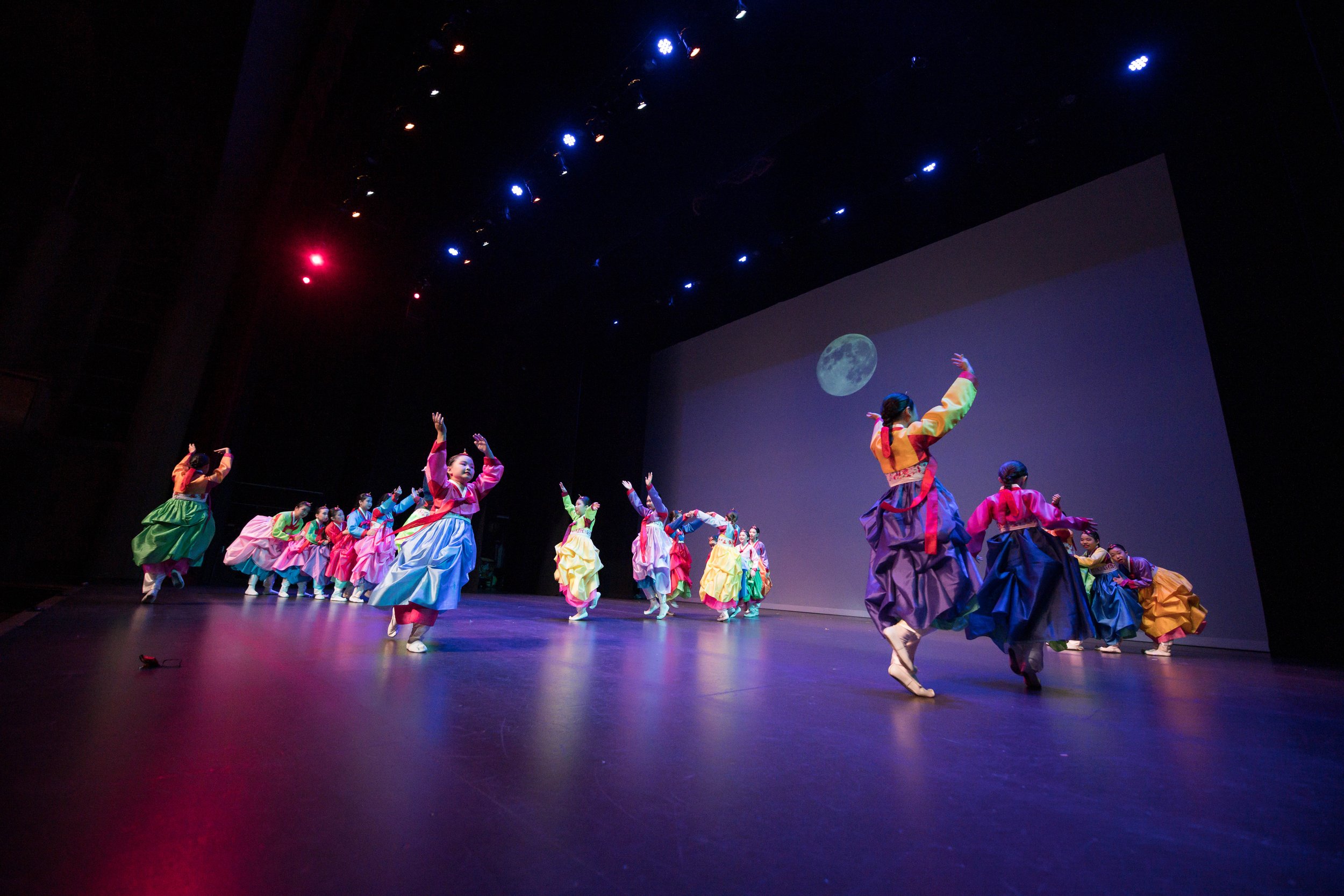
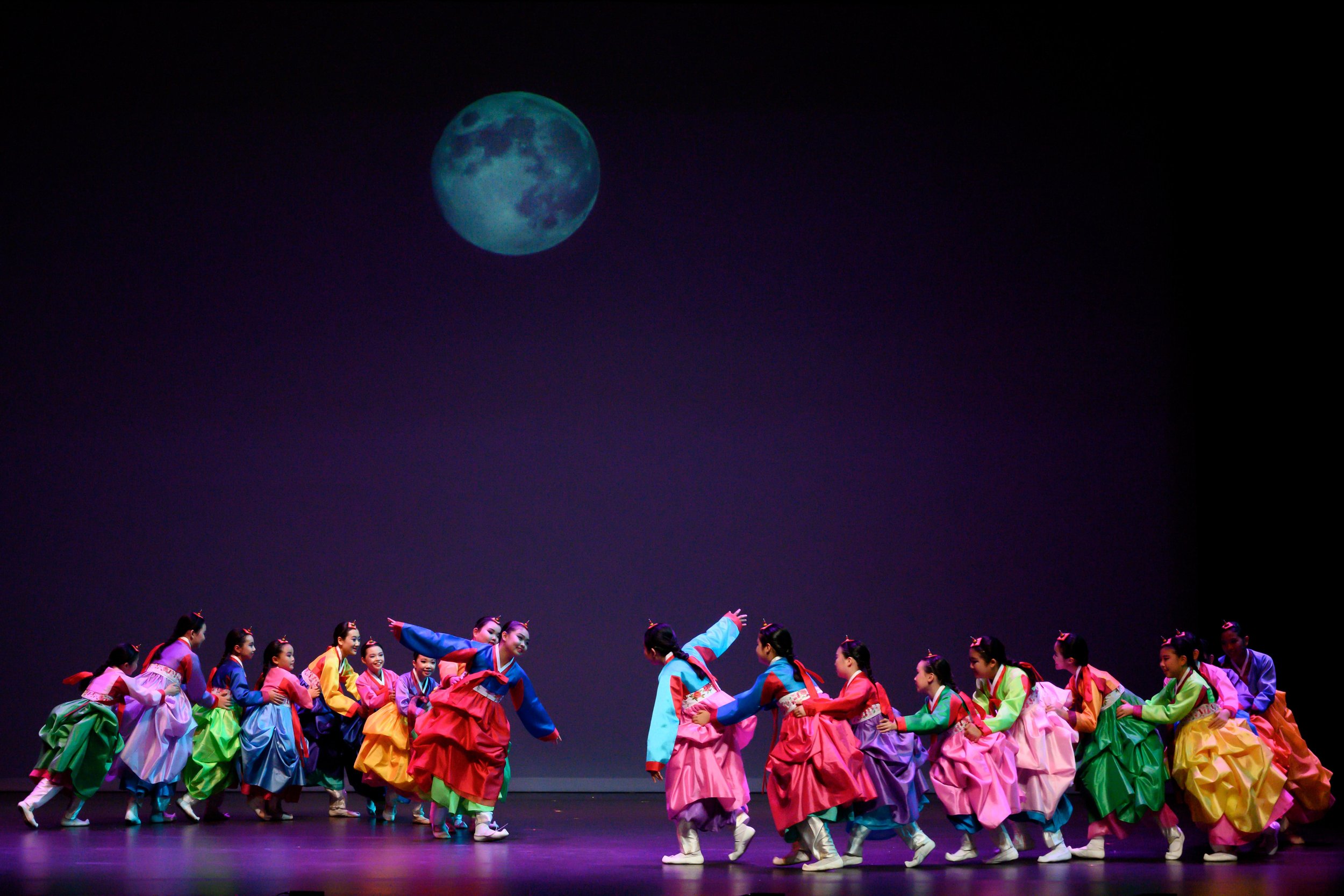
Buk-ue Hanghyun (Grand Drum Ensemble)
북의 대 향연
The drum dance was a form of entertainment for workers and farmers, and it was performed in religious ceremonies and village festivals. Among Korean musical instruments, there are many different kinds of drums, and each drum has a unique dance associated with it.
한국은 다양한 형태의 북을 가지고 있다. 북춤은 농사일 뿐만 아니라 마을의 축제및 종교의식 마을주민들의 경사등에서 추어왔다. 여러형태의 북이 다양한 형태로 따로 또는 함께 어우러져 북의 대 향연을 이룬다.
